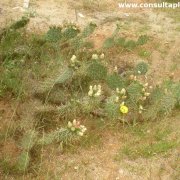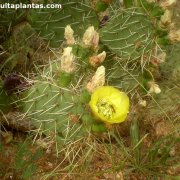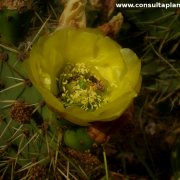Care of the cactus Opuntia engelmannii or Cactus Apple |
|
The genus Opuntia, family Cactaceae, includes some 300 species of cacti native Mexico, the USA and Central and South America. Some species are: Opuntia engelmannii, Opuntia bergeriana, Opuntia santa-rita, Opuntia rufida, Opuntia robusta, Opuntia microdasys, Opuntia linguiformis, Opuntia leucotricha, Opuntia ficus-indica, Opuntia durangensis, Opuntia subulata, Opuntia polyacantha, Opuntia lindheimeri, Opuntia aciculata, Opuntia basilaris, Opuntia atrispina, Opuntia phaeacantha, Opuntia auberi, Opuntia valida, Opuntia macrocentra, Opuntia chlorotica, Opuntia vestita, Opuntia spinulifera. Common names: Cactus Apple, Texas prickly pea, Engelmann's prickly pear, Desert Prickly Pear, Cow Tongue Prickly Pear. Scientific synonyms: Opuntia procumbens, Opuntia tricolor. This species is native to Mexico and the United States. They are fast growing, creeping cacti with grayish-green rounded segments that reach 25 cm (9.84") in diameter. They have 1-10 spines of 7 cm (2.75") in length of whitish color. The flowers are deep yellow. They produce thorny red fruits. Cactus Apple is ideal for Mediterranean coastal gardens in rockery, on dry slopes and as isolated specimens. Opuntia engelmannii prefers full sun exposure and a hot, dry climate. Do not expose it to less than 3 ºC (37.4 ºF) in winter. Cow Tongue Prickly Pear can grow in any well-drained sandy or rocky soil. Use a normal garden substrate with 30% coarse siliceous sand. Texas prickly pea will be watered moderately waiting for the substrate to have completely dried. It has high resistance to drought. Opuntia engelmannii does not need fertilizers. Prune dried segments in mid-spring or to make cuttings. Desert Prickly Pear is attacked by fungi and mealybugs if there is excess moisture. Opuntia engelmannii is propagated by rooting segments or by seeds sown in spring. |
Images of the cactus Opuntia engelmannii or Cactus Apple |
Find plants
Opuntia engelmannii or Cactus Apple | Care and Growing
© 2025 FavThemes



